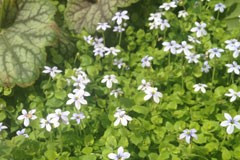
Helleborus hybridus 'Double White Seedlings'
Seed raised plants from self-pollinated flowers of "Betty Ranicar". Most of the plants will be double white, a few anemone-centred white and singles.


Often listed incorrectly as Pratia puberula; indigenous to NSW, a vigourous trailing groundcover for shady areas. Effective at suppressing weeds and performs well as mass plantings, starry light blue campanulate flowers borne over a long period. Use in combinaton with viola, epimedium, hosta.
Often listed incorrectly as Pratia puberula; indigenous to NSW, a vigourous trailing groundcover for shady areas. Effective at suppressing weeds and performs well as mass plantings, starry light blue campanulate flowers borne over a long period. Use in combinaton with viola, epimedium, hosta.
Data sheet
Seed raised plants from self-pollinated flowers of "Betty Ranicar". Most of the plants will be double white, a few anemone-centred white and singles.
We introduced this in 1996 from the UK, a lovely deep rich pink colour with single flowers on tall stems.
Select large flowered form of the species, vigorous and long flowering. Medium height bushy plant, earlier than asters but works to same effect amongst other perennials.
A useful landscaping plant for dry areas in shade or part-sun. Interesting orange berries after flowering and evergreen leaves.
One of our favourite new sedums with deep maroon and grape purple foliage. Similar in size and as easy as "Autumn Joy". Flowers start deep pink and turn terracotta, followed by wonderful seed heads in autumn.
Rich pink variety, easy cottage garden plant flowering in autumn. Combine with ornamental grasses and sedums.
Wonderful summer flowering perennial from central Europe from Afghanistan to Tibet. Lavender blue flowers during the summer, popular in eastern herbal medicine.
Native of Georgia and Turkey growing in shady places by streams in deciduous forest. A beautiful evergreen plant producing delicate porcelain blue flowers in the early spring. Works well as a mass planting beneath trees with hellebores and Geranium phaeum.
A striking biennial for shade, forming strong mounds of good foliage and normally flowers in second or third year once the plant has acheived maturity, after which it will self seed. This is the rarely offered white form, the common form is pink.
Delightful variety from Wychwood, lovely range of foliage colour including greys, purples and pinks. Distinct from 'Matrona' and 'Purple Emperor', with lower more branched form. Looks good all year both in pots and in the ground. My favourite sedum.
Attractive glossy foliage plant for shade, use as mass plantings for ground cover or grouped as specimens. Likes free draining soil in a cool position, very tough however once established, evergreen. Flowers unexciting, we usually chop off to feature the beautifully attractive leaves which can get to 20cm across.
The best red monarda; mildew resistant and tough as they come. Like all monarda, these grow best on fertile clay loam or well mulched moisture retentive soil types.
This is the rarely offered white form, lovely cut flower and cottage garden perennial. To grow effectively, avoid winter wet as much as possible and grow in a raised bed or well drained soil.
A pleasing break from the usual hot colours, a subtle kniphofia with two-toned pokers in peach and ivory.
Strawberry coloured blooms with for a sheltered morning sun position or shade, a beautiful variety that doesnt self seed as much as the usual types.
A very useful groundcovering variety which forms strong colonies in even the most difficult dry areas. Pale blue flowers in spring and autumn.

Often listed incorrectly as Pratia puberula; indigenous to NSW, a vigourous trailing groundcover for shady areas. Effective at suppressing weeds and performs well as mass plantings, starry light blue campanulate flowers borne over a long period. Use in combinaton with viola, epimedium, hosta.